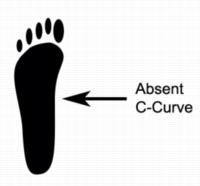26 Douglas West, Douglas, Cork. Tel : 021 489 0300/021 489 0303
26 Douglas West, Douglas, Cork. Tel : 021 489 0300/021 489 0303

The best designed shoes will not do their job if they do not fit properly.
Having your feet assessed during standing, walking and running is the best way to determine your foot type. Many specialist shoe stores can assess your feet to determine your foot type.
Alternatively a simple test to determine your foot type is the Wet Test; after a shower with your foot still wet step onto a dry surface and look at your wet footprint. If your foot print does not have a ‘C Curve’ on the inner aspect of the foot print you are likely to be a pronator. If you have a very prominent ‘C-Curve’ on the inner aspect of the foot print you are likely to be a supinator and if it is somewhere in-between you are likely to have a neutral foot.
You are likely to be a supinator and if it is somewhere in-between you are likely to have a neutral foot.

Ideal shoes should not be designed to support the foot in anyway but should provide good cushioning, comfort and stability.
These foot types require a motion control or stability shoe with a firm mid sole and good arch support. The aim with these shoes is to try and slow down pronation.
These foot types require a comfort shoe with extra cushioning. The shoe should encourage pronation. Motion control or stability shoes are not appropriate.
Copyright Neasa Long Partnership
website design by croan.ie